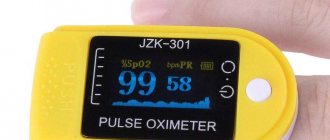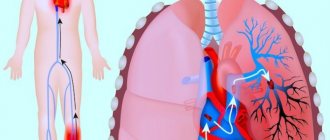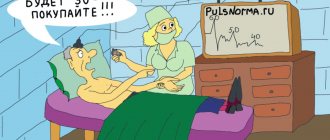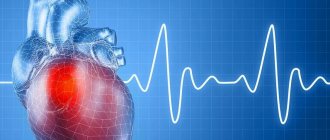Any surgical intervention is an additional trauma for the body, therefore, when determining the indications for its implementation, it is necessary to correctly balance the risk of complications, the benefits of the operation and the severity of the consequences if it is refused. Anesthesia for concomitant heart diseases itself is associated with a certain risk of complications; to assess the likelihood of their development, special indices are used that take into account the influence of risk factors:
- early or late post-infarction period;
- IHD, angina pectoris;
- rhythm disturbances: extrasystole, atrial fibrillation, bigeminy;
- high or low blood pressure;
Patients with hypertension are at risk due to possible complications during surgery
- operated and not operated heart disease;
- age, presence of concomitant diseases of other systems and organs.
Each point, depending on the severity and severity of the manifestation of disorders, is assigned a certain number of points, and based on their sum, a conclusion is made about the magnitude of the risk of complications during and after the operation. If the risk is low, it is possible to perform a full surgical intervention, and the type of anesthesia is chosen in accordance with the volume of the intended intervention. Problems during local anesthesia or anesthesia in patients in this category do not arise more often than in healthy patients.
To determine indications, select surgical techniques and pain management in patients with heart pathology, a special risk index is used, which is calculated based on the history of cardiac disease after determining the current condition.
With an average level of risk of cardiovascular complications, the least traumatic surgical technique is chosen, with which the desired effect can be achieved. In patients with coronary artery disease and rhythm disturbances, especially atrial fibrillation, if possible, preference is given to local regional anesthesia in combination with sedation; in case of heart defects, this issue is resolved individually depending on the type of pathology. If there is a high risk of complications, operations are performed solely for life-saving reasons; in this case, as a rule, general anesthesia is used.
The choice of anesthesia depending on the type of operation
Endotracheal anesthesia
Surgeries on the respiratory organs, heart and blood vessels are performed exclusively under general endotracheal anesthesia, since this is the only method of pain relief that can provide adequate analgesia and maintenance of vital functions during such interventions. Open abdominal surgeries are also performed under general anesthesia, since it is impossible to provide a good level of pain relief and muscle relaxation for a long period using a spinal or epidural block without the risk of additional complications.
When performing laparoscopic operations, interventions on the pelvic organs, perineum, rectum, lower extremities, the choice of anesthesia is carried out taking into account the volume of the operation and the type of concomitant cardiac pathology. In preparation for a planned operation, the patient should be examined by an anesthesiologist in advance. In this case, he will be able to prescribe all the necessary studies and consultations with related specialists after his examination, and this makes it possible to choose the correct technique and tactics of local anesthesia.
Electropulse therapy for atrial fibrillation
With atrial fibrillation, fibrillation of the upper chambers of the heart is observed (they beat intensely - up to 400 beats / min), as a result of which a rapid and uneven pulse is observed. Treatment with an electric current pulse is often used for atrial fibrillation, except for the constant form and duration of the disease (more than 2 years). Before performing electric pulse therapy (EPT), the patient is given a short-acting general anesthesia so that the patient does not feel discomfort and pain from the electric current. In some situations, there are complications from the anesthesia used for EIT. Then other types of pain relief are used. Their use should be carried out by an experienced anesthesiologist who is well acquainted with the specifics of administering anesthesia for cardiac and vascular diseases.
Preparation for surgery under general anesthesia
To prepare for surgery, patients with cardiovascular pathology are prescribed an extensive examination. In addition to the ECG, echocardiography, cardiac ultrasound, and exercise tests are prescribed. For patients with extrasystole, cardiac arrhythmia, especially its atrial fibrillation form, as well as clinical manifestations of sinus bradycardia, 24-hour Holter monitoring is necessary. In addition, blood pressure is regularly measured and the full range of laboratory tests provided for in the standard scheme is carried out.
The decision to stop taking medications for maintenance therapy is made by the cardiologist together with the attending physician and anesthesiologist, usually done as follows:
- Nitrodrugs, adrenergic blockers and vasodilators, calcium channel blockers are taken until the day of surgery. Cardiac glycosides are discontinued several days before the procedure; to maintain the contractility of the heart, the anesthesiologist will inject special short-acting drugs intravenously;
- Indirect anticoagulants, which are usually taken by patients after valve replacement, stenting or coronary artery bypass surgery, are replaced 4-5 days before surgery with direct ones (heparin, fraxiparin are administered) to make it easier to manage hemostasis during surgery.
Direct acting anticoagulant drug
- Patients operated on for congenital and acquired heart valve defects and having endoprostheses can be operated on only after a prophylactic course of antibacterial therapy, this is necessary to prevent the development of infective endocarditis.
In the presence of cardiac arrhythmia, additional therapeutic measures are carried out:
- When cardiac arrhythmia is detected, it is important to determine its cause and take measures to eliminate it. It can be caused by ischemia of the myocardium, incorrect selection of drugs or their side effects. Ventricular extrasystole may be associated with a sudden cessation of smoking in patients with a long history of smoking.
- Atrial fibrillation is a relative contraindication to elective surgery. Surgical intervention is possible only in the normosystolic form, that is, when the contraction of the ventricles, despite the inadequate functioning of the atria, occurs in a “normal” mode. If the rhythm of atrial fibrillation cannot be restored with the use of antiarrhythmic drugs, a temporary pacemaker should be considered.
It is important to know: preparation for surgery for patients with diseases of the cardiovascular system includes examination by a cardiologist and correction of previously recommended prescriptions. Patients with atrial fibrillation are examined especially carefully.
Man consulting with a cardiologist
Physiological sinus bradycardia in trained individuals does not have a negative effect on the course of anesthesia; in the presence of clinical symptoms, this condition requires correction or installation of a pacemaker. In addition, additional drugs may be prescribed to correct the rhythm in atrial fibrillation and extrasystole, as well as to improve coronary circulation.
Therapeutic physical training classes
Dynamic aerobic exercise for some cardiac pathologies improves a person’s condition, increases his mental abilities and physical activity. However, in some cases, patients with arrhythmia should not exercise:
- severe heart disorders in the post-infarction state;
- stable atrial fibrillation (various contractions of the ventricles in frequency and strength);
- constant sudden (paroxysmal) attacks of tachycardia;
- coronary heart disease with repeated attacks of angina pectoris;
- heart defects;
- obvious cardiac conduction disturbances;
- heart failure;
- aortic aneurysm (sac-like protrusion of a vessel);
- diseases of the endocrine system;
- kidney and liver dysfunction;
- inflammation of the inner wall of a blood vessel with the formation of a blood clot of the lower extremities (thrombophlebitis);
- type 1 diabetes mellitus;
- hypertension.
Excessive exercise can lead to serious complications and death. Therefore, training can begin with light exercises under the supervision of specialists: a physical therapy trainer and a cardiologist. During exercise there should be no discomfort, pain in the heart area, shortness of breath, severe fatigue or swelling of the legs.
Features of general anesthesia for cardiovascular pathology
Regardless of the method of anesthesia, in the presence of coronary artery disease, angina pectoris, cardiac arrhythmia, including atrial fibrillation and extrasystole, constant cardiorespiratory monitoring is necessary throughout the operation. A cardiogram is recorded, pulse, blood pressure and blood oxygen saturation levels are measured. This helps to promptly recognize bradycardia, an increase or decrease in blood pressure, as well as myocardial hypoxia and prescribe medications that will help restore heart function.
When performing general anesthesia, drugs with minimal effect on hemodynamics should be chosen. To minimize the negative impact, combined anesthesia is used. To prevent bradycardia, anticholinergic blockers (atropine) are included in the premedication.
Anticholinergic drug for premedication
Strictly prohibited exercises for arrhythmia
Strength exercises are absolutely contraindicated in patients with cardiac arrhythmia. Since such loads impede the normal functioning of the respiratory system, as well as the cardiovascular system. There is an improper redistribution of blood between organs and tissues, and the “steal” syndrome is observed. That is, blood flow increases in hard-working muscles, while the heart experiences oxygen starvation. Therefore, patients should forget about barbells, dumbbells, strength training equipment, and expanders. Abdominal exercises and yoga with extremely difficult asanas should also be avoided.
How can anesthesia affect the functioning of the heart and how to get rid of the consequences?
Modern drugs for anesthesia and local anesthesia are completely eliminated from the body within 24 hours after anesthesia and cease to have any effect on the heart. Only intraanesthetic complications can affect the functioning of this organ: acute disturbances in the rhythm and blood supply to the myocardium, disturbances in the rhythm of breathing and electrolyte balance during surgery. Such complications are diagnosed while the patient is in the hospital, so the doctor has the opportunity to prescribe adequate treatment.
If unusual sensations appear in the heart area after undergoing surgery under general anesthesia, you should consult a doctor: pain or stabbing in the chest can occur not only due to heart disease, other organs may be involved in the process.
If, after an operation under general anesthesia, a stabbing sensation begins in the heart area or weakness, dizziness and increased fatigue appear, this may be a manifestation of asthenic syndrome. In this case, it is possible to restore normal well-being after surgery by normalizing sleep and rest patterns and a healthy diet. It is recommended to eat bananas, dried fruits and nuts, eat small portions at least 4 times a day and spend 1-2 hours outdoors every day.
(Ratings: 3 , average: 5.00 )
Symptoms of bradycardia
Even with satisfactory health, women during pregnancy need to maintain normal pulse and blood pressure values (70 heart beats per minute; 120/70 mmHg). This is necessary to prevent fetal hypoxia and amniotic fluid embolism - both conditions are not accompanied by symptoms.
Signs of bradycardia occur when the heart rate decreases to less than 60 beats per minute - the body’s compensatory mechanisms become insufficient, which leads to a deterioration in the blood supply to the brain and muscles of the limbs:
- constant fatigue, drowsiness;
- frequent changes in blood pressure;
- pain, tightness and discomfort in the chest;
- memory impairment;
- lack of concentration;
- confusion in thoughts, slow flow of thought processes;
- noise and “ringing” in the ears;
- dizziness;
- hyperhidrosis (sweating);
- “flies” before the eyes.
If the pressure drops to 40 heart beats per minute, Adams-Morgagni-Stokes syndrome may develop:
- excitement, panic, fear of death;
- blueness of the nasolabial triangle, swelling of the jugular veins;
- pupil dilation.
Then there is a loss of consciousness, during which the person may develop convulsions, and relaxation of the sphincters. This condition occurs when heart rhythm disturbances lead to an acute lack of blood circulation to the brain. It requires urgent emergency care.
Rules for the use of anesthesia for cardiac arrhythmia
If arrhythmia is diagnosed, the risk of administering anesthesia before surgery doubles. If surgery is urgent and urgent, the doctor is obliged to take all necessary measures: prepare the patient, collect data on his diagnosis, and assess the risk of complications.
After this, anesthesia is administered using certain drugs. After the operation is completed, the patient undergoes a rehabilitation period.
Preparatory stage
Before performing surgery, all the necessary tests are taken from a patient with arrhythmia and a number of studies are carried out:
- Electrocardiogram of the heart. Detection of pathological changes on the ECG directly affects the choice of drug. Atrial fibrillation is one of the most important indicators for this study, influencing the final decision of the anesthesiologist.
- Analysis for blood group and Rh factor. Data is required in case of unforeseen circumstances for donation.
- General and chemical blood test. During the study, the level of protein, bilirubin, cholesterol and other indicators is determined.
- Coagulogram. A blood clotting test will help avoid complications due to blood loss.
- Chest X-ray. The study allows us to exclude tuberculosis and the development of lung pathologies.
Preparing a patient with arrhythmia for surgery also includes completely quitting smoking and alcohol, undergoing a course of treatment for chronic diseases and normalizing weight.
In addition, premedication is carried out - drug preparation for the intervention.
Features of administering anesthesia for arrhythmia
Before administering the drug, the doctor must talk with the patient to find out if he has any contraindications to a particular anesthetic drug. During this conversation, as well as on the basis of the collected data, the anesthesiologist finally decides on the choice of drug and type of anesthesia.
The introduction goes like this:
- anesthesia is introduced into the patient’s body using a catheter, sometimes an inhalation mask is used instead;
- throughout the operation, anesthesia enters the bloodstream, providing the patient with sound sleep;
- in case of arrhythmia, the patient is given special medications before surgery to normalize heart function and stabilize blood pressure;
- Doctors carefully monitor all indicators of heart function during surgery.
Anesthesia drugs used for arrhythmia
Depending on the type of anesthesia, different drugs will be used:
- General anesthesia. When performing short-term operations on patients with arrhythmia, monoanesthesia is used, which involves the administration of one drug. Doctors often use Ketamine. Also for patients with arrhythmia, a 1% solution of Hexenal and sodium thiopental are used. To prevent bradycardia, atropine is additionally administered.
- Local anesthesia. During simple surgical interventions (for example, in dentistry), topical anesthesia is used with the administration of the drugs “Lidocaine” and “Kamistad”. In maxillofacial surgery, Novocain is used, and when administering local anesthesia, Trimecain is often used. During childbirth, as well as operations on the legs or spine, epidural and spinal anesthesia are used. In this case, the drugs Mepivacaine and Ropivacaine are used.











